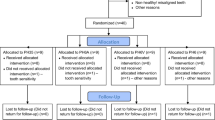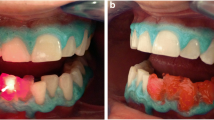Abstract
The purpose of this randomized, parallel, triple-blinded clinical trial was to compare efficacy and tooth sensitivity (TS) after use of an in-office bleaching agent of 6 % hydrogen peroxide containing nanoparticles of nitrogen-doped titanium oxide (HP6) vs. 35 % hydrogen peroxide (HP35). Forty-eight volunteers were randomly divided either a HP6 or HP35. Two clinical sessions were performed with an interval of 7 days between them for each group. In each session, two consecutive applications of each bleaching agent were performed and activated by a hybrid LED/laser light. Efficacy was determined by color alteration (ΔE), recorded with reflectance spectroscopy. It was assessed at baseline and after the first and second bleaching session. TS was characterized according to occurrence, intensity, duration, and type. Efficacy was analyzed by repeated measures analysis of variance (ANOVA) and post hoc Bonferroni test, and TS was analyzed by means of chi2 test (α = 0.05). For HP35, highest and significant values of ΔE were found after bleaching when compared to HP6 (p = 0.002). However, HP35 showed a significantly higher occurrence of TS than HP6 (p = 0.008). Also, intensity and duration were higher in HP35. The majority of volunteers classified the type experienced in their sensitivity in the form of a “shock.” The use of HP6 despite reducing efficacy when compared to an in-office bleaching in higher concentration (35 %) produced less tooth sensitivity. Clinical relevance: In terms of tooth sensitivity, the use of lower concentrations of in-office bleaching should be the first choice, suggesting greater biocompatibility and safety compared to a conventional HP35.


Similar content being viewed by others
References
Dahl J, Pallesen U (2003) Tooth bleaching—a critical review of the biological aspects. Crit Rev Oral Biol Med 14:292–304
Bruzell EM, Pallesen U, Thoresen NR, Wallman C, Dahl JE (2014) Side effects of external tooth bleaching. Br Dent J 215:E17
Kossatz S, Martins G, Loguercio AD, Reis A (2012) Tooth sensitivity and bleaching effectiveness associated with use of a calcium-containing in-office bleaching gel. J Am Dent Assoc 143:e81–e87
Martin J, Fernandez E, Bahamondes V, Werner A, Elphick K, Oliveira O Jr, Moncada G (2013) Dentin hypersensitivity after teeth bleaching with in-office systems. Randomized clinical trial. Am J Dent 26:10–14
Benetti AR, Valera M, Mancini M, Miranda C, Balducci I (2004) In vitro penetration of bleaching agents into the pulp chamber. Int Endod J 37:120–124
de Souza Costa CA, Riehl H, Kina JF, Sacono NT, Hebling J (2010) Human pulp responses to in-office tooth bleaching. Oral Surg Oral Med Oral Pathol Oral Radiol Endod 109:e59–e64
DA Roderjan SR, Hebling J, de Souza Costa CA, Soares DG, Reis A, Loguercio AD (2014) Histopathological features of dental pulp tissue from bleached mandibular incisors. J Mater Sci Eng B 4:8
Hanks CT, Fat JC, Wataha JC, Corcoran JF (1993) Cytotoxicity and dentin permeability of carbamide peroxide and hydrogen peroxide vital bleaching materials, in vitro. J Dent Res 72:931–938
Soares DG, Basso FG, Hebling J, de Souza Costa CA (2014) Concentrations of and application protocols for hydrogen peroxide bleaching gels: effects on pulp cell viability and whitening efficacy. J Dent 42:185–198
Soares DG, Ribeiro APD, da Silveira VF, Hebling J, de Souza Costa CA (2012) Efficacy and cytotoxicity of a bleaching gel after short application times on dental enamel. Clin Oral Investig 17:1901–1909
Reis A, Kossatz S, Martins GC, Loguercio AD (2013) Efficacy of and effect on tooth sensitivity of in-office bleaching gel concentrations: a randomized clinical trial. Oper Dent 38:386–393
Moncada G, Sepúlveda D, Elphick K, Contente M, Estay J, Bahamondes V, Fernandez E, Oliveira O, Martin J (2013) Effects of light activation, agent concentration, and tooth thickness on dental sensitivity after bleaching. Oper Dent 38:467–476
Bortolatto JF, Pretel H, Floros MC, Luizzi ACC, Dantas AAR, Fernandez E, Moncada G, de Oliveira OB (2014) Low concentration H2O2/TiO_N in office bleaching: a randomized clinical trial. J Dent Res 93:66S–71S
Schulz KF, Altman DG, Moher D (2010) CONSORT 2010 statement: updated guidelines for reporting parallel group randomised trials. BMC Med 8:18
Bortolatto JF, Pretel H, Neto CS, Andrade MF, Moncada G, Junior OBO (2013) Effects of LED–laser hybrid light on bleaching effectiveness and tooth sensitivity: a randomized clinical study. Laser Phys Lett 10:085601
Kossatz S, Dalanhol A, Cunha T, Loguercio A, Reis A (2011) Effect of light activation on tooth sensitivity after in-office bleaching. Oper Dent 36:251–257
Reis A, Dalanhol AP, Cunha TS, Kossatz S, Loguercio AD (2011) Assessment of tooth sensitivity using a desensitizer before light-activated bleaching. Oper Dent 36:12–17
Hoffmann G (2000) Cie color space. online http://www.fho-emdende/hoffmann/-ciexyz29082000pdf
Jorgensen MG, Carroll WB (2002) Incidence of tooth sensitivity after home whitening treatment. J Am Dent Assoc 133:1076–1082
Asahi R, Morikawa T, Ohwaki T, Aoki K, Taga Y (2001) Visible-light photocatalysis in nitrogen-doped titanium oxides. Science 293:269–271
Suyama Y, Otsuki M, Ogisu S, Kishikawa R, Tagami J, Ikeda M, Kurata H, Cho T (2009) Effects of light sources and visible light-activated titanium dioxide photocatalyst on bleaching. Dent Mater J 28:693–699
Tano E, Otsuki M, Kato J, Sadr A, Ikeda M, Tagami J (2012) Effects of 405 nm diode laser on titanium oxide bleaching activation. Photomed Laser Surg 30:648–654
Kishi A, Otsuki M, Sadr A, Ikeda M, Tagami J (2011) Effect of light units on tooth bleaching with visible-light activating titanium dioxide photocatalyst. Dent Mater J 30:723–729
Sulieman M, Addy M, MacDonald E, Rees J (2004) The effect of hydrogen peroxide concentration on the outcome of tooth whitening: an in vitro study. J Dent 32:295–299
Brännström M, Aström A (1972) The hydrodynamics of the dentine: its possible relationship to dentinal pain. Int Dent J 22:219–227
Markowitz K (2010) Pretty painful: why does tooth bleaching hurt? Med Hypotheses 74:835–840
Trindade FZ, Ribeiro APD, Sacono NT, Oliveira CF, Lessa FCR, Hebling J, Costa CAS (2009) Trans‐enamel and trans‐dentinal cytotoxic effects of a 35% H2O2 bleaching gel on cultured odontoblast cell lines after consecutive applications. Int Endod J 42:516–524
Li Y (1997) Toxicological considerations of tooth bleaching using peroxide-containing agents. J Am Dent Assoc 128:31S–36S
Pinto CF, Oliveira RD, Cavalli V, Giannini M (2004) Peroxide bleaching agent effects on enamel surface microhardness, roughness and morphology. Braz Oral Res 18:306–311
Charakorn P, Cabanilla LL, Wagner WC, Foong WC, Shaheen J, Pregitzer R, Schneider D (2009) The effect of preoperative ibuprofen on tooth sensitivity caused by in-office bleaching. Oper Dent 34:131–135
Cartagena AF, Parreiras SO, Loguercio AD, Reis A, Campanha NH (2015) In-office bleaching effects on the pulp flow and tooth sensitivity–case series. Braz Oral Res 29:1–6
Thitinanthapan W, Satamanont P, Vongsavan N (1999) In vitro penetration of the pulp chamber by three brands of carbamide peroxide. J Esthet Dent 11:259–264
Marson FC, Gonçalves RS, Silva CO, Cintra L, Pascotto RC, Santos PH, Briso ALF (2014) Penetration of hydrogen peroxide and degradation rate of different bleaching products. Oper Dent 40:72–79
de Almeida LC, Costa CA, Riehl H, dos Santos PH, Sundfeld RH, Briso AL, Brito-Júnior M, Nobre SA, Freitas JC, Camilo CC (2012) Occurrence of sensitivity during at-home and in-office tooth bleaching therapies with or without use of light sources. Acta Odontol Latinoam 25:3–8
Bowles WH, Burns H (1992) Catalase/peroxidase activity in dental pulp. J Endod 18:527–534
Anderson DG, Chiego DJ, Glickman GN, McCauley LK (1999) A clinical assessment of the effects of 10% carbamide peroxide gel on human pulp tissue. J Endod 25:247–250
Morse DR (1991) Age-related changes of the dental pulp complex and their relationship to systemic aging. Oral Surg Oral Med Oral Pathol 72:721–745
Bernick S, Nedelman C (1975) Effect of aging on the human pulp. J Endod 1:88–94
Acknowledgments
This study was supported by CAPES.
We thank NUPEN and the undergraduate students Rafaela Nanami Handa Inada, Camila Yumi Morita, and Priscila Petrucelli Freire de Carvalho for the technical and scientific support.
We gratefully acknowledge the contribution of Michael Floros (Trent University, ON, Canada) for his English language and grammar corrections.
This research received no specific grant from any funding agency in the public, commercial, or not-for-profit sectors.
Author information
Authors and Affiliations
Corresponding author
Ethics declarations
Ethical approval
All procedures performed in studies involving human participants were in accordance with the ethical standards of the institutional and/or national research committee and with the 1964 Helsinki declaration and its later amendments or comparable ethical standards.
Informed consent
Informed consent was obtained from all individual participants included in the study.
Conflict of interest
The authors declare that they have no competing interests.
Additional information
Trial registration: U1111-1150-4466
Rights and permissions
About this article
Cite this article
Bortolatto, J.F., Trevisan, T.C., Bernardi, P.S.I. et al. A novel approach for in-office tooth bleaching with 6 % H2O2/TiO_N and LED/laser system—a controlled, triple-blinded, randomized clinical trial. Lasers Med Sci 31, 437–444 (2016). https://doi.org/10.1007/s10103-016-1866-2
Received:
Accepted:
Published:
Issue Date:
DOI: https://doi.org/10.1007/s10103-016-1866-2




